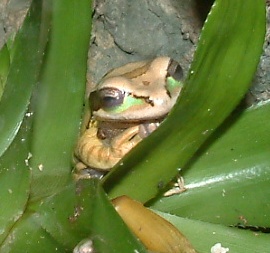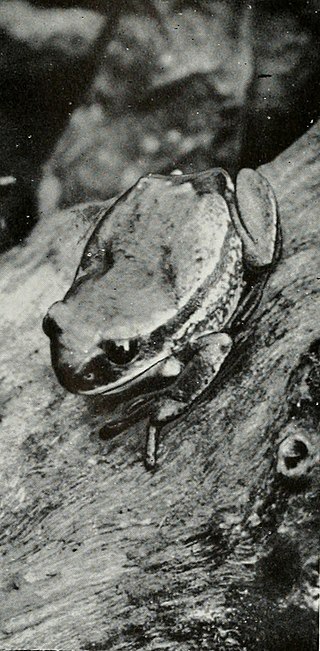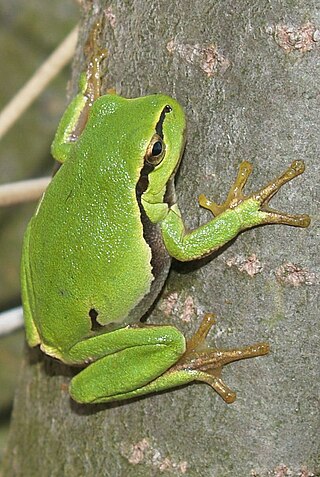
Hylidae is a wide-ranging family of frogs commonly referred to as "tree frogs and their allies". However, the hylids include a diversity of frog species, many of which do not live in trees, but are terrestrial or semiaquatic.

Litoria is a genus of hylid tree frogs, sometimes collectively referred to as Australasian treefrogs.

The Mexican burrowing tree frog (Smilisca), also known as the cross-banded tree frog, is a genus of frogs in the family Hylidae found in Mexico, southern Texas and Arizona, Central America, and northwestern South America. In a recent revision of the Hylidae, the two species of the previous genus Pternohyla were included in this genus. Its name is from the Ancient Greek smiliskos, referring to the pointed frontoparietal processes.

Tyler's tree frog or the southern laughing tree frog is an arboreal species of tree frog. It is native to eastern Australia where it occurs from south-eastern Queensland to the southern coast of New South Wales. It is generally a coastal species and is not found inland.

The common Mexican tree frog is a nocturnal species of tree frog whose native range extends from the Sonoran Desert and the Lower Rio Grande Valley of Texas south to Costa Rica. Common names include Mexican tree frog, Baudin's tree frog and Van Vliet's frog. They are usually found within lightly forested areas near permanent sources of water.

The blue-spotted Mexican tree frog is a species of frog in the family Hylidae found on the Atlantic slopes of southeastern Mexico, Belize, and Guatemala, between Jalapa de Díaz in Mexico and Sierra del Mico in Guatemala. Its natural habitats are humid mid-altitude and montane forests, and it can also occur in secondary forest. Breeding takes place in temporary pools and streams and in depressions in logs that fill up with water. It is threatened by habitat loss and, potentially, chytridiomycosis.
The upland burrowing tree frog is a species of frog in the family Hylidae. It is endemic to Mexico and occurs in southeastern Aguascalientes and adjacent northern Jalisco at elevations of 1,800–1,900 m (5,900–6,200 ft) asl. Its natural habitats are flooded grasslands where it breeds in temporary and permanent pools. It is a rare species that is threatened by habitat loss caused by conversion into agricultural land and the subsequent pesticide pollution.

The lowland burrowing tree frog or northern casquehead frog is a species of frog in the family Hylidae. It is found in south-central Arizona, the United States, and southward along the coastal plain and foothills to Western and South-Central Mexico. Its natural habitats are open mesquite grassland and tropical scrub forests at elevations from near sea level to about 1,490 m (4,890 ft) above sea level. It is a burrowing frog that is common in rain-filled temporary pools, its breeding habitat. It is threatened by habitat loss caused by agricultural development. However, many well-preserved populations have been recorded.

The New Granada cross-banded tree frog, also known as the masked tree frog, is a species of frog in the family Hylidae found in Colombia, Costa Rica, Ecuador, Honduras, Nicaragua, and Panama. Its natural habitats are subtropical or tropical dry forest, subtropical or tropical moist lowland forest, rivers, freshwater marshes, intermittent freshwater marshes, plantations, rural gardens, urban areas, heavily degraded former forests, ponds, and canals and ditches.

The Nicaragua cross-banded tree frog or tawny smilisca is a species of tree frog in the family Hylidae. It is found in the Caribbean lowlands of Costa Rica and adjacent Nicaragua to about 520 m (1,710 ft) above sea level. Its natural habitats are tropical moist lowland forests. It breeds in small, shallow temporary pools or ponds, including those in very disturbed habitats, such as pastures. Males call during the rainy season from shallow water and low bushes. Habitat loss and degradation caused by small- and large-scale agriculture and logging are threats to this species.

The Panama cross-banded tree frog or pug-nosed tree frog is a species of frog in the family Hylidae found in the humid Pacific lowlands of southwestern Costa Rica to eastern Panama and in the Caribbean lowlands of Panama and northern Colombia. Males of the species utilize synchronous calling to hide their position from predators. Females create basins during amplexus and deposit fertilized eggs onto the surface of the water.

The Veragua cross-banded tree frog is a species of frog in the family Hylidae found in Colombia, Costa Rica, Honduras, Nicaragua, and Panama. Its natural habitats are subtropical or tropical moist lowland forests, subtropical or tropical moist montane forests, rivers, plantations, rural gardens, urban areas, heavily degraded former forests, and canals and ditches. Scientists have observed it as high in the hills as 1525 meters above sea level.

Anchieta's tree frog, also known as the Huila forest treefrog, is a species of frog in the family Arthroleptidae. It is endemic to Angola. It is closely related to the West Cameroon forest tree frog and the Garamba forest tree frog.

The palm forest tree frog is a species of frog in the family Arthroleptidae which is endemic to Príncipe island in São Tomé and Príncipe. Red tree frog Leptopelis rufus from the African mainland was for a long time included in this species, but is now considered a distinct species.

The highland frog, also known as the masked mountain frog, is a species of frog in the family Ranidae, known from El Salvador, Guatemala, Honduras, Mexico, and Nicaragua. Its natural habitats are subtropical or tropical moist lowland forests, subtropical or tropical moist montane forests, rivers, and freshwater marshes. It is threatened by habitat loss.

The spiny tree frog is a species of frog in the family Rhacophoridae. It is endemic to the Philippines and occurs on Mindanao, Leyte, Bohol, and Basilan, possibly wider.

Hylinae is a large subfamily of "tree frogs", family Hylidae.

















